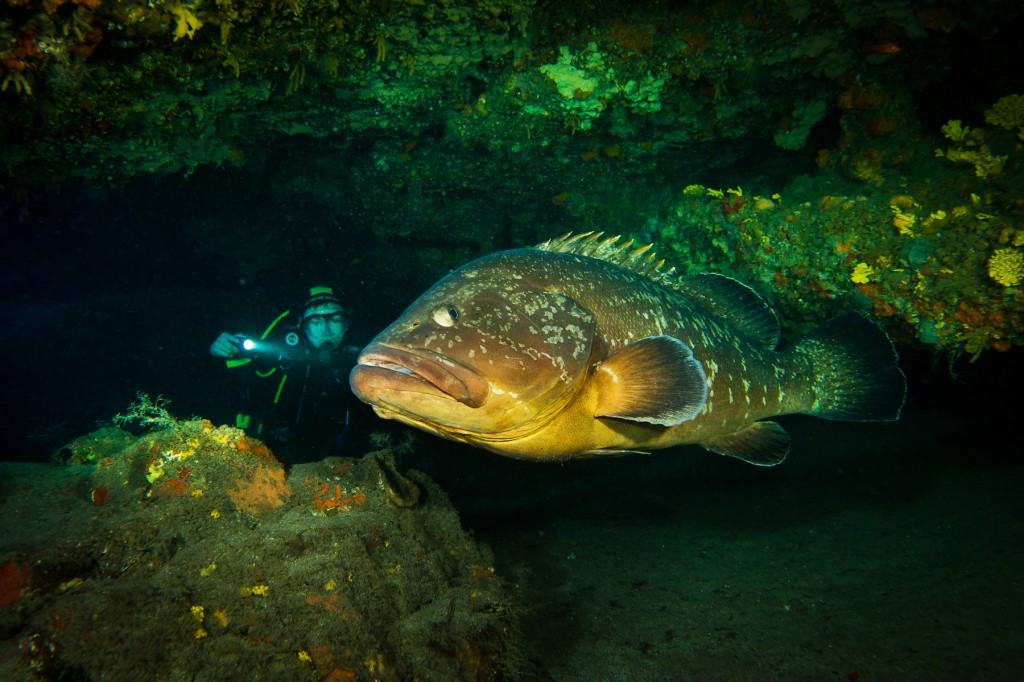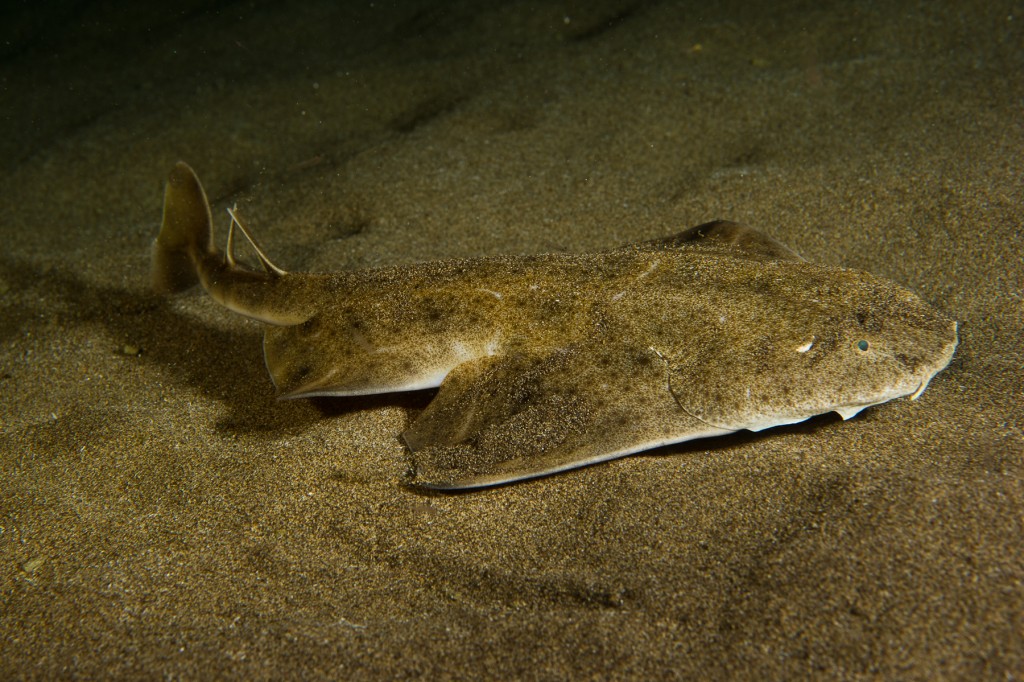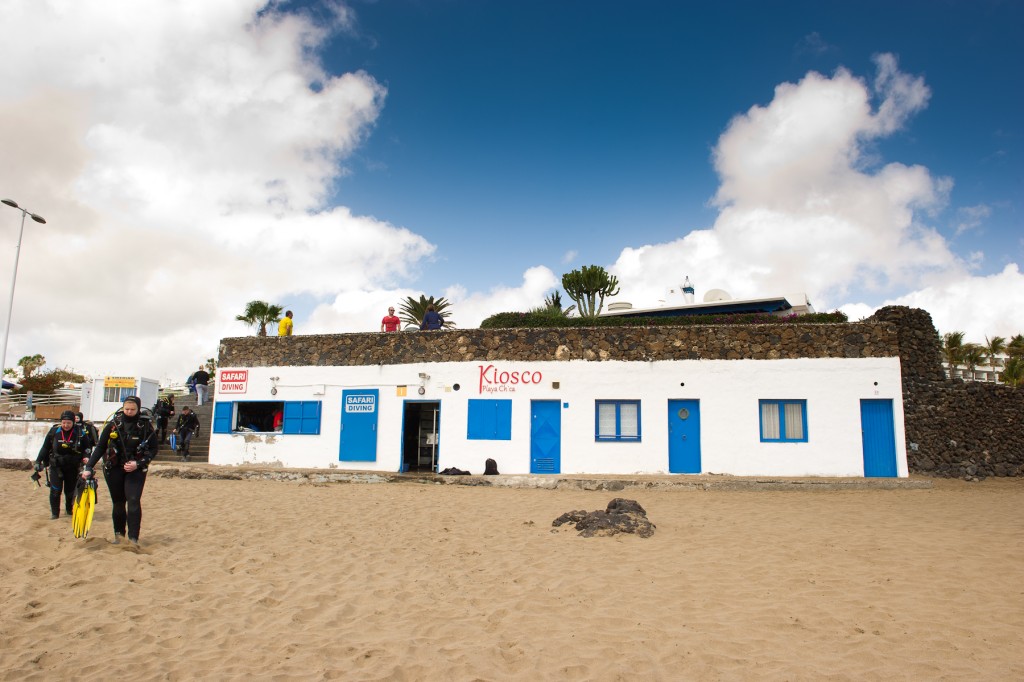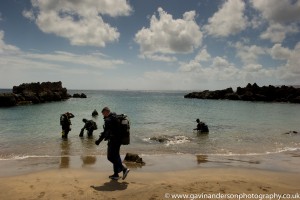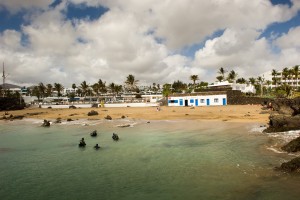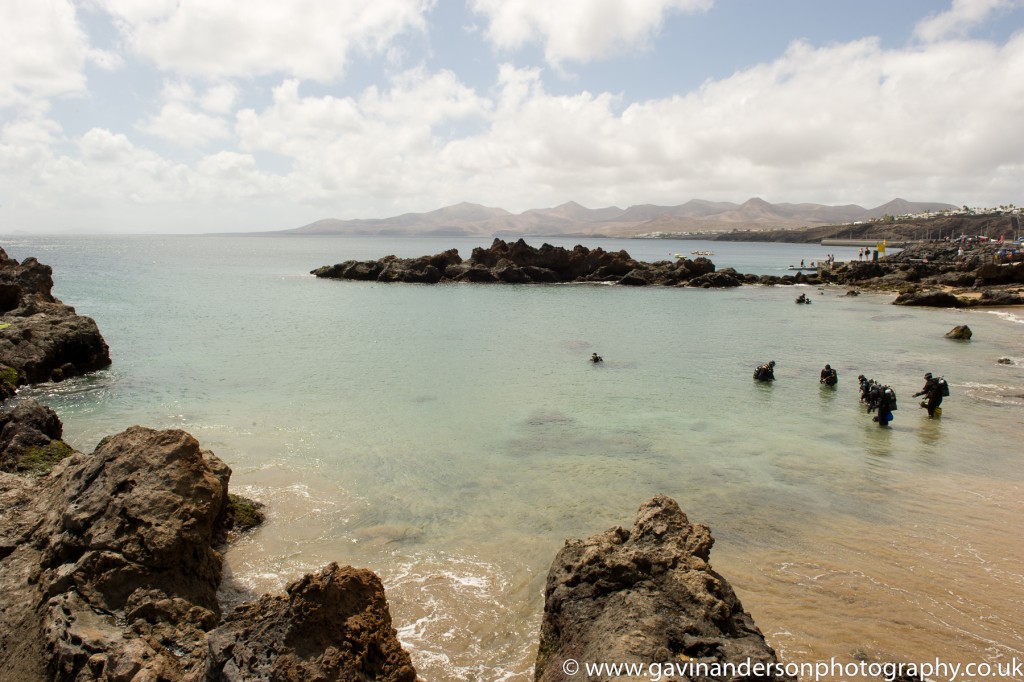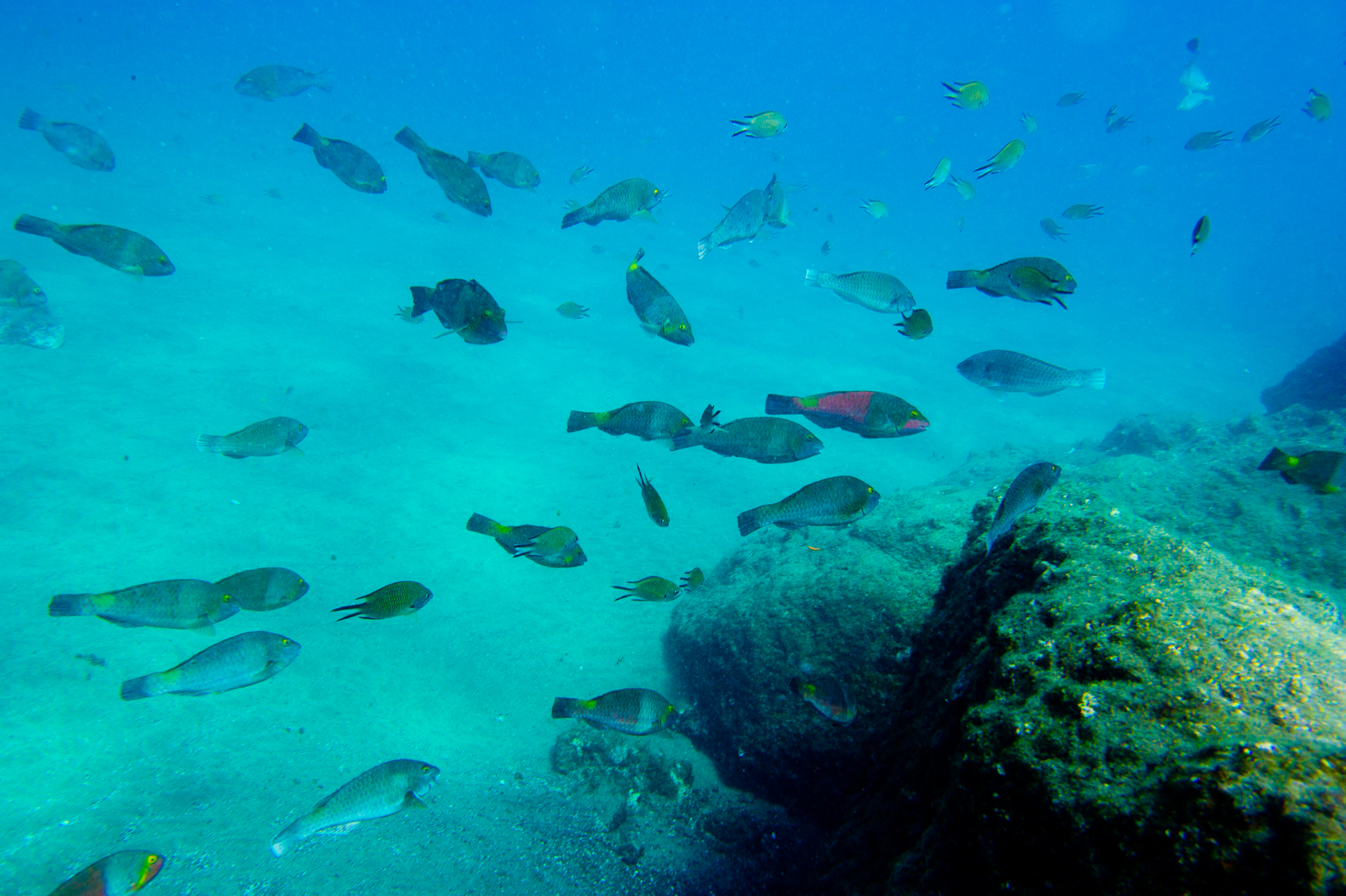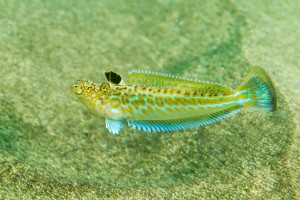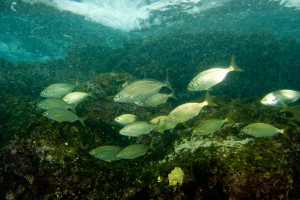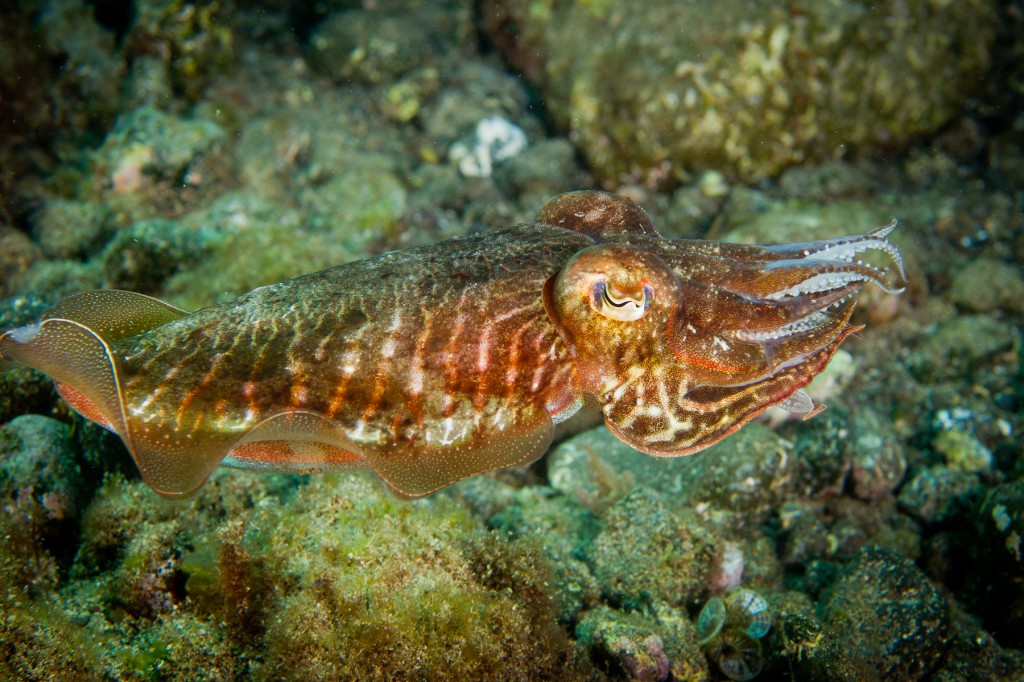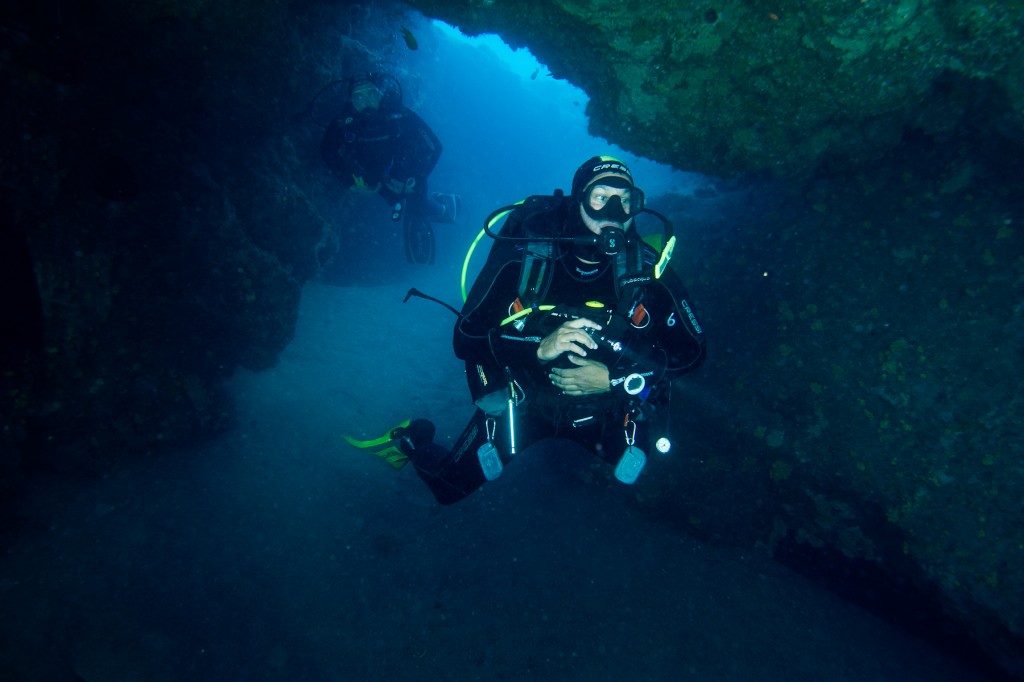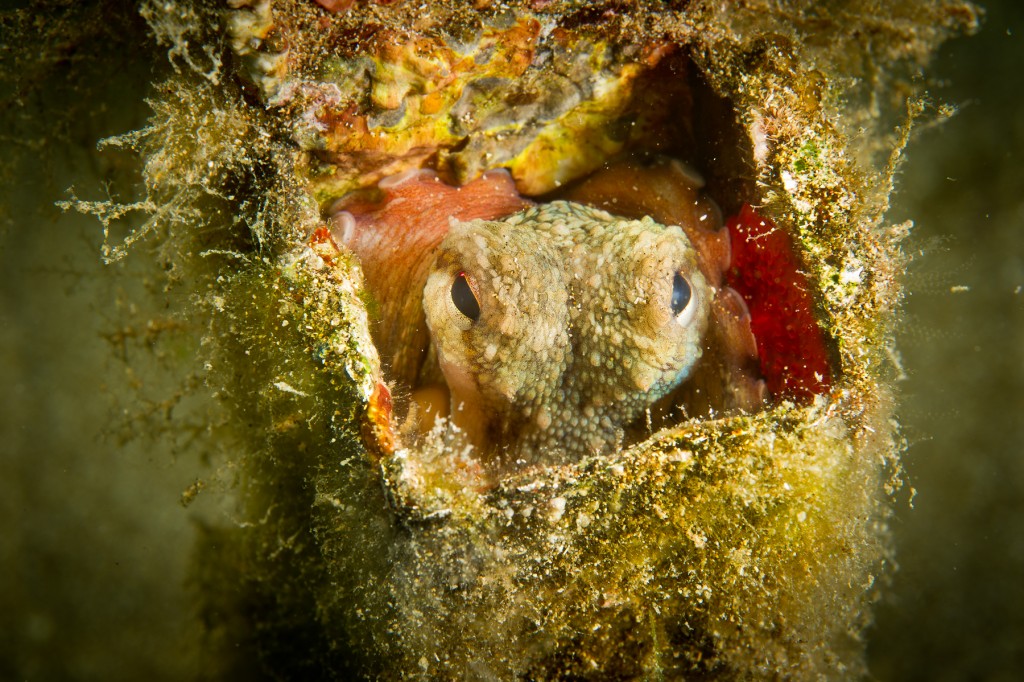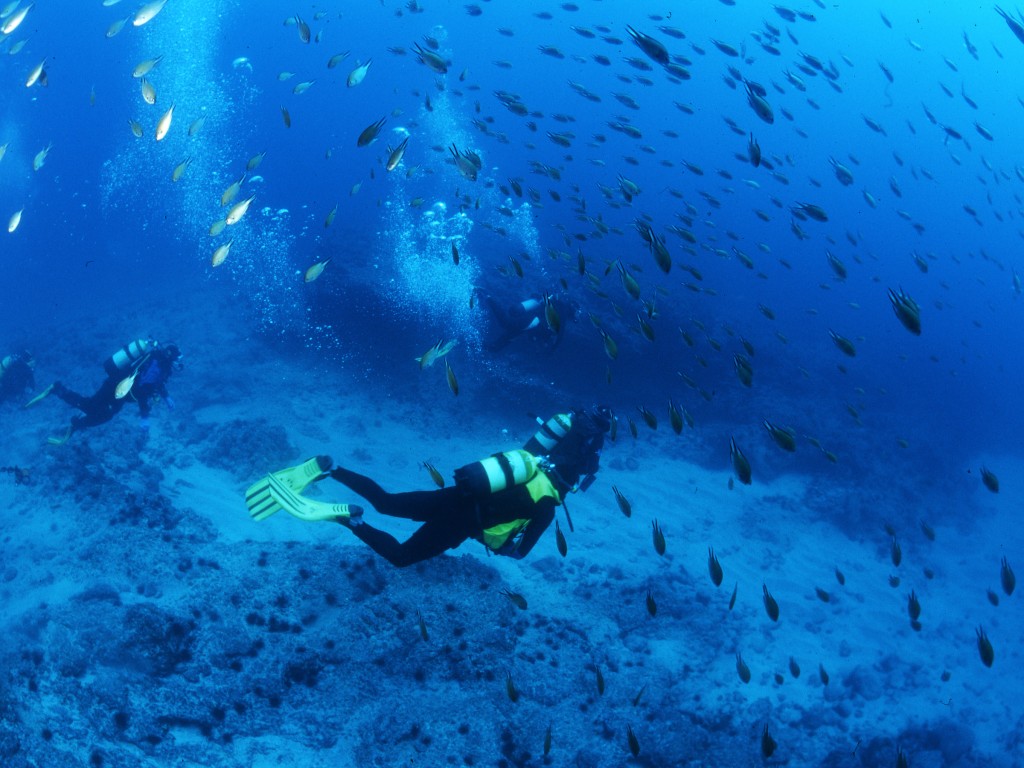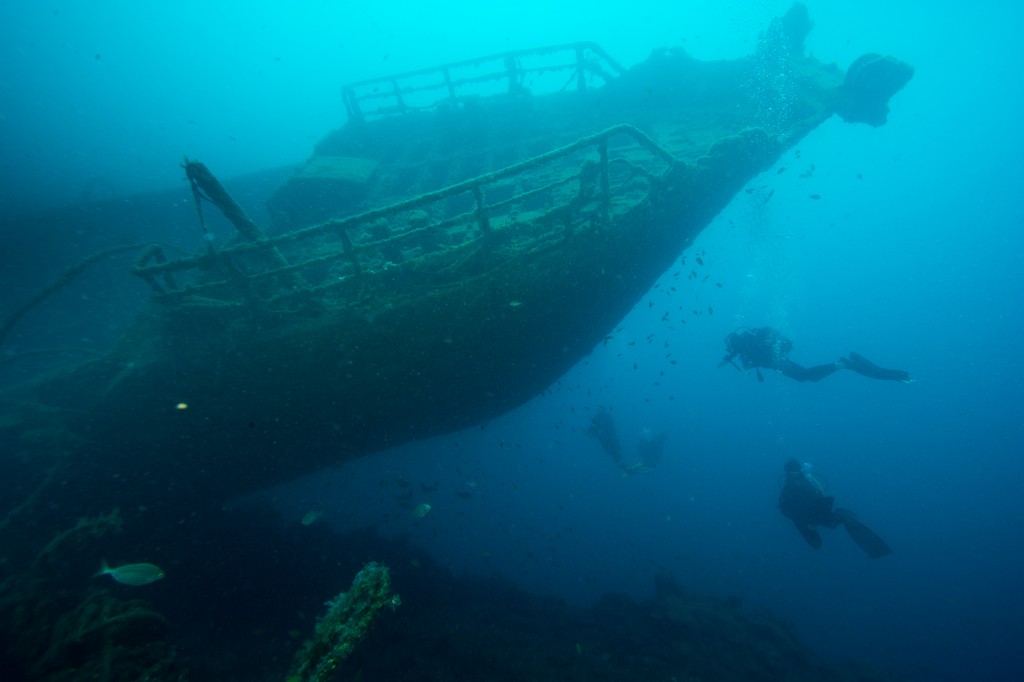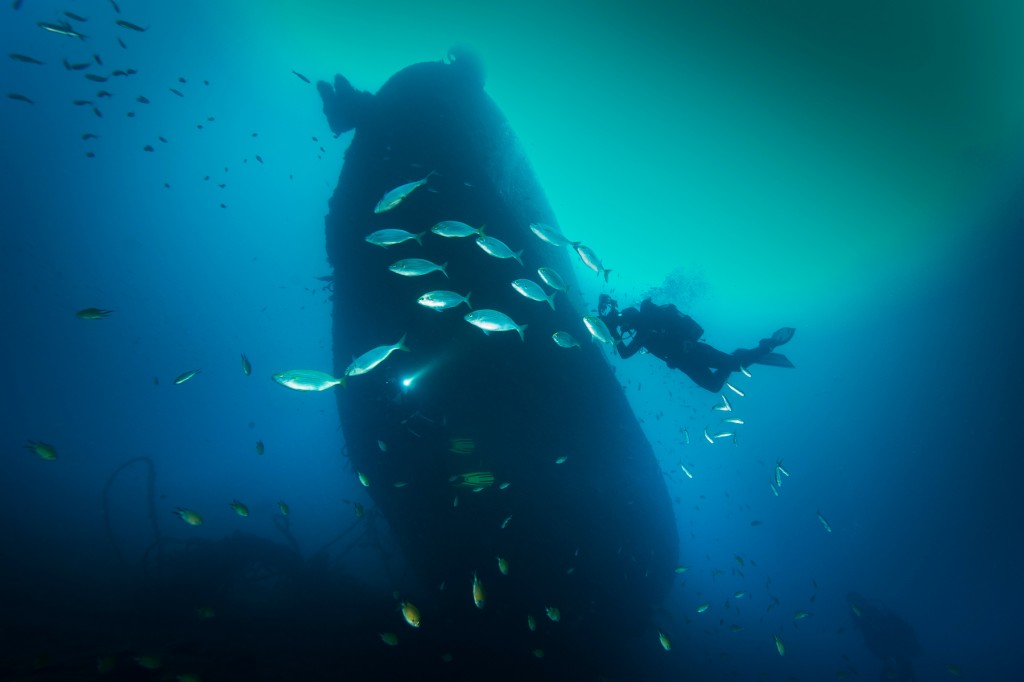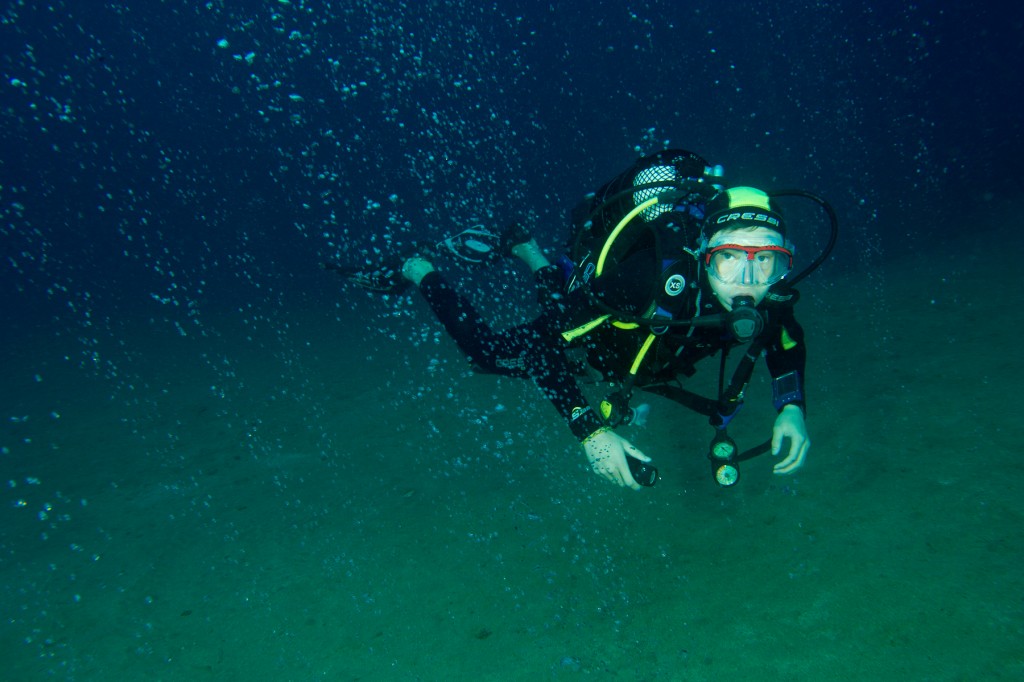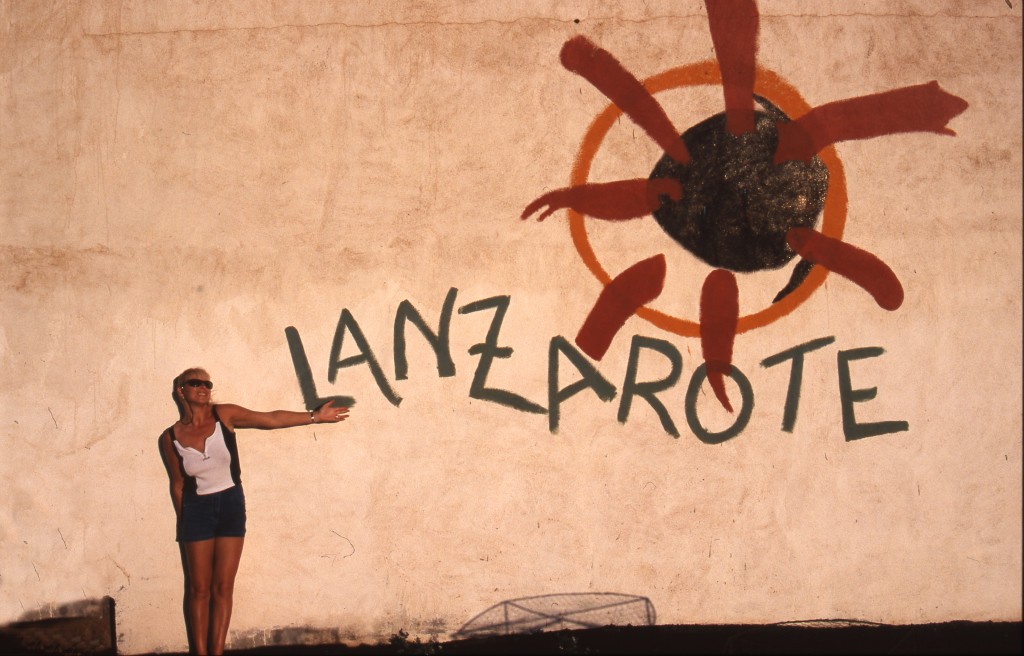News
Spring Break in Lanzarote
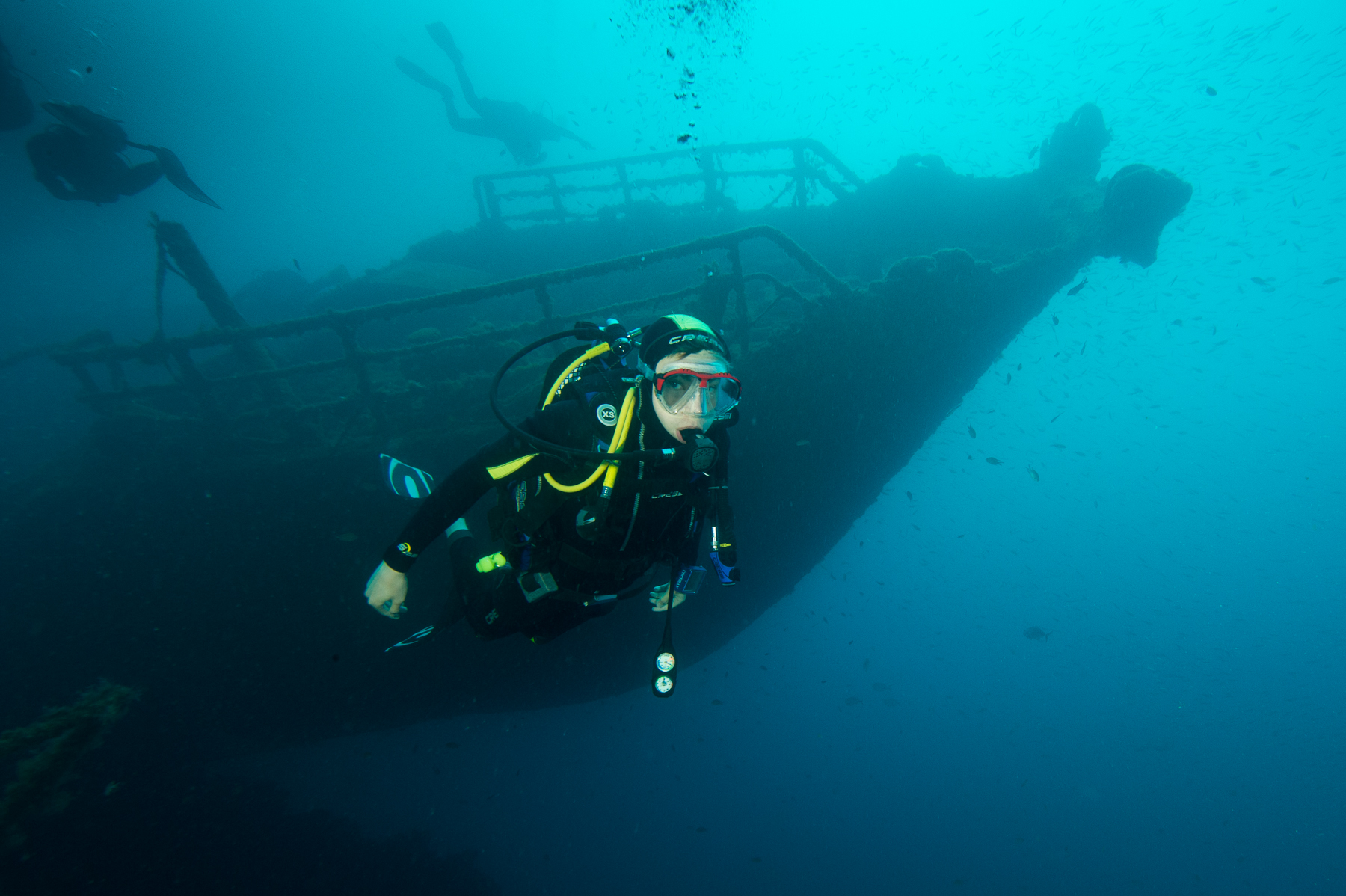
We were a less than a metre away from one of the largest groupers I’d seen in a long time. She hovered motionless under a deep overhang, her beautifully silky smooth skin glistening in our torch lights. Unlike many of the groupers we’d already seen she was remarkably at ease despite our close contact. This was her spot, large and confident and used to divers, she wasn’t moving! It was a great moment – just one of many we were having on this dive trip.
We were still just in the month of March; the Easter holidays had just started and Spring was imminent. My stepson and I had come to an old favourite short haul holiday destination of mine, Lanzarote. He was doing his advanced open water course, and I was enjoying some real easy diving, not too far from home, where hopefully we’d have some great weather and good value for money diving. I’d spent my honeymoon here, visited my first volcano, explored amazing bleak scenery and seen my first Angel shark. I was hoping Arthur would share similar experiences too and even perhaps see his first Angel shark.
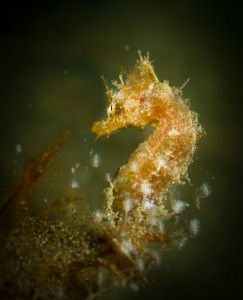 Lanzarote is one of seven volcanic islands that make up the Canaries. Located in the Atlantic Ocean around one hundred miles of the coast of Morocco they cover an area of some 550 kilometres. Part of Spain, Tenerife, Lanzarote, Grand Canaria, Fuerteventura and La Palma are the biggest and easiest to get to, with the least developed, smallest and most unspoilt islands El Hiero and La Gomera. Due a ‘hot spot’ in the Earth’s crust the islands have been volcanically active for thousands of years. Most of the islands mass is below sea level meaning only the very tips of the volcanoes emerge above the water. The last eruption was in 1971 at Teneguia on La Palma.
Lanzarote is one of seven volcanic islands that make up the Canaries. Located in the Atlantic Ocean around one hundred miles of the coast of Morocco they cover an area of some 550 kilometres. Part of Spain, Tenerife, Lanzarote, Grand Canaria, Fuerteventura and La Palma are the biggest and easiest to get to, with the least developed, smallest and most unspoilt islands El Hiero and La Gomera. Due a ‘hot spot’ in the Earth’s crust the islands have been volcanically active for thousands of years. Most of the islands mass is below sea level meaning only the very tips of the volcanoes emerge above the water. The last eruption was in 1971 at Teneguia on La Palma.
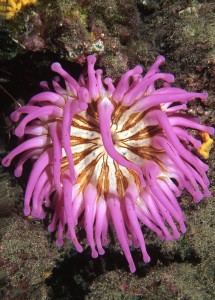 Each island has something to offer. Tenerife has Mount Teide, the third highest volcanic structure and most voluminous in the world. Lanzarote has the Timanfaya volcano and a national park. Here, just 10 metres below the surface, temperatures approaching 600 degrees are still recorded! This is despite the last volcano erupting here over 250 years ago.
Each island has something to offer. Tenerife has Mount Teide, the third highest volcanic structure and most voluminous in the world. Lanzarote has the Timanfaya volcano and a national park. Here, just 10 metres below the surface, temperatures approaching 600 degrees are still recorded! This is despite the last volcano erupting here over 250 years ago.
Lanzarote is the lazy diver’s dream. Right off the shore in the busy tourist resort of Puerto del Carmen there are a whole host of fantastic dive sites. They are found off the beach between Playa Chica and the old harbour. There is even a dive centre located right on the beach. Safari Diving is ironically named as it suggests going on some Red Sea adventure using tents; to the contrary, it’s in a dream location opposite a shallow sheltered bay. With new equipment (all the top brands) for rent at reasonable rates, a range of excellent dive masters and English owners Wendy and husband Steve, it’s the perfect place for either beginners learning for the first time or experienced divers like myself looking for a hassle free service.
The sea is literally a few steps from the dive centre, and once you’ve swum a little distance out and descended on to a sandy bottom, you find yourself swimming past small wrasse and damsel fish, parrot fish, and schools of bream patrolling up and down the bay’s protected mini cliffs.
We were diving one of Playa Chica’s most famous sites, the Cathedral. We’d swum straight out from the dive centre and slowly descended past 20 metres over the sand, past a colony of garden eels, the odd flounder and weever fish, some frisky cuttlefish, and arrived at the main drop off. Here the bottom had fallen away quite sharply well past 40 metres. To our right we’d briefly explored the top of the wreck of a small boat, before crossing back to our left to a small outcrop to look at the large old blind moray who has lived here for at least the last 8 years (although perhaps not always blind!). We then ducked under the overhang and found our giant lady grouper. I had wondered how many divers she had watched pass this spot in just one day! Since the troubles in Egypt, Turkey and the migrant situation on other islands such as Greece, many more divers were heading to the Canaries, with diver numbers up well in excess of 30 percent!
We had spent the week on guided dives, but now that Arthur had qualified we’d rented tanks and got in the water ahead of the crowds. It was sadly overcast and the visibility was only around 10 metres, not its more normal 20 to 30, but still better than the east coast back in the UK! The water was just about warm enough – we were in 7mm wetsuits (although I had seen the odd instructor still in a drysuit!). Leaving the Grouper behind we headed further to our left and into the darkness. We were entering the Cathedral, a vast cave which many divers could fit in to – which was just as well, as by the time we reached the back a group was entering, their lights a faint glow at first as they headed towards us. As they got closer I could see their leader was wearing a drysuit and tick gloves and in a technical diver’s crossed-arms pose! He made me feel colder than I actually was, seeing him kitted up more typically for a dive in UK waters!
We left them swiftly and headed out the cave and back to the sloping sand, back past more frisky cuttlefish, flounders, lizard fish and garden eels. Arthur delighted in swimming through the bubbles we’d left in the cave, which were now percolating through small holes in the roof. They were being added to all the time by more divers beneath us. Moving up the sand before heading back into the bay and exiting at the beach we explored the rocky wall to our right, where groups of parrot fish cruised in and out of little gullies and a group of mullet worked the sand around the walls base, closely followed by some goatfish and bream. At 6 metres this was a perfect place to spend a 5 minute safety stop at the end of our dive.
There are more than a half dozen great dives off the beach at Playa Chica. The Cathedral is the most accessible and scenic but the Blue Hole is also high on people’s list. Earlier in the week I joined one of Safari Diving’s group dives while Arthur did his course. Also in the group was someone I hadn’t seen for over 20 years, another keen photographer called John Collins from Ireland. It was great to catch up with John and swap stories on Photo and diving gear etc. To reach the Blue Hole we had jumped off the harbour steps a short walk along the front from the dive centre. Swimming out to the Hole took longer than the swim to the Cathedral, but it was nice scenic dive, starting with a deepish swim through starting in around 18 metres and exiting at about 26 metres. Once through the swim through we explored a small cave full of encrusting life and a few small shrimps. Below us we watched 2 nice sized Groupers slowly swim away. I also joined John on Safari Diving’s harbour wreck boat dive. It left as planned at 2.30pm, again from the harbour steps.
Arthur was also on our dive doing one of the specialties for his course. The dive is one of the best in Lanzarote and most people’s favourite. Some 35 years ago, between 6 and 7 wrecks were purposely sunk by the first dive centre on Lanzarote. Mostly old fishing vessels, some literally on top of others, can be explored at depths from just 14 metres down to about 40 metres. Well protected from the worst weather, the wrecks have remained in relatively good condition. The first wreck you come to literally hangs off the side of the harbour wall, resting on the reef, its stern now full of rocks which were put there during the recent harbour wall rebuild.
As we cruised round and down beneath its bow, a lovely shoal of bream cruised by above us. We soon dropped down to 30 metres right on top of the next 2 wrecks, which seemed to be sitting on top of each other. There was a bow section, some winches, and various other parts of wreckage, some of which was covered in fishing nets. Much of the wreck’s original wooden decking was still in place. Swimming on a bit further more wrecks appeared; it was all a bit of a huddle though – it was hard to make out where one started and the other ended! A real mashup of hulls, decking, machinery and fishing equipment, it was all a bit hard to take in at 30 metres with one eye on my computer and the other on Arthur doing his first real deep dive!
On another day I’d like to go deeper and explore the wreck which was just out of our time and depth. It’s found between 35m and 40m and known as the “Propeller” wreck, because it still has its iron propeller and rudder.
Arthur really enjoyed his first combined wreck and boat dive, and when I asked him at the end of the week which his favourite dive was, it was a three way tie. I was definitely in agreement; as well as the wreck and boat dive, the other two were his first night dive and our dive at the Atlantic Museum down at Playa Blanca. It was dark by 8.30pm and we entered the water at about 9pm right off the beach from the dive centre. Arthur was amazed at how far we could see underwater and by the amazing bioluminescence which we could see when we switched our torches off and swiped our hands through the water. Our guide Debs was brilliant, coping well in showing five of us various night time creatures – some sleeping, some active, such as octopus and squid, spider crabs and sea hairs. I think the most memorable find was an angel shark so well camouflaged, at first all we could see was its green eye poking out through the sand! With a few of us feeling the cold the dive was over after just 45 minutes, and I reluctantly exited with everyone else. After nearly 30 years diving I still absolutely love night dives, the time just shoots by and I always feel I could stay a lot longer!
There is one dive site you don’t want to miss on Lanzarote. Located on the south west side of the island at Playa Blanca, The Atlantic Museum consists of many incredible sculptures which have being installed on the seafloor in Colaradas Bay in Playa Blanca at a depth of 15 metres. The museum, the first in Europe of its kind, has been designed by British artist Jason deCaires Taylor, who has created similar creations in Cancun, Mexico and Grenada in the West Indies. The creation is sure to be a mega attraction for divers.
Keep an eye out for my report on the Atlantic Museum on Scubaverse soon!
Summary
Volcanic scenery and volcanoes still smoking, secret lagoons, fantastic beaches, water parks, guaranteed sunshine and turquoise waters all just 4 hours from the UK. What are you waiting for? Book some winter sun and spring diving now!
Oh, just one tip – take a thick wetsuit (unless your going in summer or autumn!).
Gavin dived with Steve and Wendy Hicks at Safari Diving Lanzarote. For more information, visit www.safaridiving.com.
LANZAROTE FACT FILE
Water temperature:
17°C (63°F) in February to 24°C (75°F) in August
A drysuit may be preferable in winter months, although a 7mm semidry should also be sufficient. 5mm wet suit should be fine in summer.
Visibility:
20 – 30 metres (65 – 100 feet)
Type of diving:
Caves, tunnels, sheer walls, wrecks
Marine life:
Angel sharks, rays, moray eels, garden eels, cuttlefish, octopus, lobsters, jacks, barracuda, grouper, trumpetfish, scorpionfish, parrotfish, wrasse
When to go:
All year, although June to October may be preferable if you prefer warmer water. Winter is the best season for the Angel sharks.
How to get there:
From the UK – numerous flights direct from all major airports. Flight time is about 4 hours.
Accommodation:
All inclusive 3 star with flights you can get for £499 with Jet 2 holidays
Blogs
Northern Red Sea Reefs and Wrecks Trip Report, Part 2: Wall to Wall Wrecks

Jake Davies boards Ghazala Explorer for an unforgettable Red Sea diving experience…
The second day’s diving was a day full of wreck diving at Abu Nuhas, which included the Chrisoula K, Carnatic, and Ghiannis D. The first dive of the day was onto the Chrisoula K, also known as the wreck of tiles. The 98m vessel remains largely intact where she was loaded with tiles which can be seen throughout the hold. The stern sits at 26m and the bow just below the surface. One of the highlights of the wreck is heading inside and seeing the workroom where the machinery used for cutting the tiles are perfectly intact. The bow provided some relaxing scenery as the bright sunlight highlighted the colours of the soft coral reef and the many reef fish.

Following breakfast, we then headed to the next wreck, which was the Carnatic. The Carnatic is an 89.9m sail steamer vessel that was built in Britain back in 1862. She ran aground on the reef back in 1869 and remains at 27m. At the time, she was carrying a range of items, including 40,000 sterling in gold. An impressive wreck where much of the superstructure remains, and the two large masts lay on the seafloor. The wooden ribs of the hull provide structures for lots of soft corals, and into the stern section, the light beams through, bouncing off the large shoals of glass fish that can be found using the structure as shelter from the larger predators that are found outside of the wreck.

The final wreck at Abu Nuhas was the Ghiannis D, originally called ‘Shoyo Maru,’ which was 99.5m long and built in Japan back in 1969 before becoming a Greek-registered cargo ship in 1980. The ship then ran aground on the reef on April 19th, 1983, and now sits at the bottom at a depth of 27m. Heading down the line, the stern of the ship remains in good condition compared to the rest of the hull. The highlight of the wreck, though, is heading into the stern section and down the flights of stairs to enter the engine room, which remains in good condition and is definitely worth exploring. After exploring the interior section of the ship, we then headed over to see the rest of the superstructure, where it’s particularly interesting to see the large table corals that have grown at the bow relatively quickly considering the date the ship sank. After surfacing and enjoying some afternoon snacks, we made sure everything was strapped down and secured as we would be heading north and crossing the Gulf of Suez, where the winds were still creating plenty of chop.

The next morning, it was a short hop to Ras Mohammed Nature Reserve for the next couple of days of diving. The 6am wake-up call came along with the briefing for the first site we would be diving, which was Shark & Yolanda. The low current conditions allowed us to start the dive at Anemone City, where we would drift along the steep, coral-filled wall. These dives involved drifts, as mooring in Ras Mohammed wasn’t allowed to protect the reefs. As a dive site, Shark & Yolanda is well-known and historically had a lot of sharks, but unfortunately not so many in recent years, especially not so early in the season. However, there was always a chance when looking out into the blue.

The gentle drift took us along the steep walls of the site, with plenty of anemone fish to be seen and a huge variety of corals. It wasn’t long into the dive before we were accompanied by a hawksbill turtle, who drifted with us between the two atolls before parting ways. Between the two reefs, the shallow patch with parts of coral heads surrounded by sand provided the chance to see a few blue-spotted stingrays that were mainly resting underneath the corals and are always a pleasure to see. With this being the morning dive, the early sunlight lit up the walls, providing tranquil moments. Looking out into the blue, there was very little to be seen, but a small shoal of batfish shimmering underneath the sunlight was a moment to capture as we watched them swim by as they watched us.

Towards the end of the dive, we stopped at the wreck of the Jolanda where the seafloor was scattered with toilets from the containers it was carrying. This provided a unique site to make a safety stop, which was also accompanied by a large barracuda slowly swimming by, along with a hawksbill turtle calmly swimming over the reef as the sun rays danced in the distance.
For the next dive, we headed north to the Strait of Tiran to explore the reefs situated between Tiran Island and Sharm El Sheik, which were named after the British divers who had found them. We started on Jackson before heading to Gordons Reef, where we also did the night dive. All the atolls at these sites provided stunning, bustling coral reefs close to the surface and steep walls to swim along, which always provided the opportunity to keep an eye out for some of the larger species that can be seen in the blue. Midwater around Jackson Reef was filled with red-toothed triggerfish and shoals of banner fish, which at times were so dense that you couldn’t see into the blue. Moments went by peacefully as we enjoyed the slow drift above the reef, watching these shoals swim around under the mid-afternoon sun.

The night dive at Gordon’s Reef was mainly among the stacks of corals surrounded by sand, which was great to explore under the darkness. After some time circling the corals, we came across what we were really hoping to find, and that was an octopus hunting on the reef. We spent the majority of the dive just watching it crawl among the reef, blending into its changing surroundings through changes in colour and skin texture. It’s always so fascinating and captivating to watch these incredibly intelligent animals, in awe of their ability to carry out these physical changes to perfectly blend into the reef. Before we knew it, it was time to head back to the boat to enjoy a well-deserved tasty dinner prepared by the talented chefs onboard.
Check in for the 3rd and final part of this series from Jake tomorrow!
To find out more about the Northern Red Sea reef and wrecks itineraries aboard Ghazala Explorer, or to book, contact Scuba Travel now:
Email: dive@scubatravel.com
Tel: +44 (0)1483 411590
Photos: Jake Davies / Avalon.Red
Marine Life & Conservation
Double Bubble for Basking Sharks

 The Shark Trust is excited to announce that, for two more days only, all donations, large or small, will be doubled in the Big Give Green Match Fund!
The Shark Trust is excited to announce that, for two more days only, all donations, large or small, will be doubled in the Big Give Green Match Fund!
Donate to Basking in Nature: Sighting Giants
The Shark Trust is hoping to raise £10k which will be doubled to £20k. This will go towards Basking in Nature: Sighting Giants. And they need YOUR help to reach they’re goal.
The Shark Trust’s citizen science project is to monitor and assess basking sharks through sightings; encouraging data collection, community engagement, and promoting nature accessibility. This initiative aims to enhance health and wellbeing by fostering a deeper connection with British Sharks.
Campaign Aims
- Increase citizen science reporting of Basking Sharks and other shark sightings to help inform shark and ray conservation.
- Provide educational talks about the diverse range of sharks and rays in British waters and accessible identification guides!
- Create engaging and fun information panels on how to ID the amazing sharks and rays we have on our doorstep! These can be used on coastal paths around the Southwest. With activities and information on how you can make a difference for sharks and rays!
- Promote mental wellbeing through increasing time in nature and discovering the wonders beneath the waves!
Donate, and double your impact. Click Here
-

 News3 months ago
News3 months agoHone your underwater photography skills with Alphamarine Photography at Red Sea Diving Safari in March
-

 News3 months ago
News3 months agoCapturing Critters in Lembeh Underwater Photography Workshop 2024: Event Roundup
-

 Marine Life & Conservation Blogs2 months ago
Marine Life & Conservation Blogs2 months agoCreature Feature: Swell Sharks
-

 Blogs2 months ago
Blogs2 months agoMurex Resorts: Passport to Paradise!
-

 Blogs2 months ago
Blogs2 months agoDiver Discovering Whale Skeletons Beneath Ice Judged World’s Best Underwater Photograph
-

 Gear Reviews3 months ago
Gear Reviews3 months agoGear Review: Oceanic+ Dive Housing for iPhone
-

 Marine Life & Conservation2 months ago
Marine Life & Conservation2 months agoSave the Manatee Club launches brand new webcams at Silver Springs State Park, Florida
-

 News3 months ago
News3 months agoWorld’s Best Underwater Photographers Unveil Breathtaking Images at World Shootout 2023


